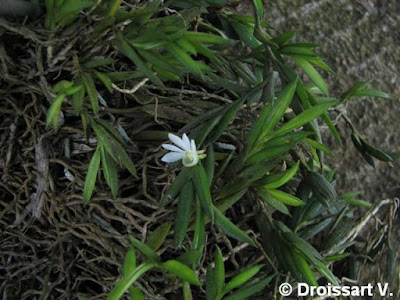Angraecum gabonense is endemic to Lower Guinea and Congolian Domains of the Guineo-Congolian Region. It is usually found in dense lowland forest rich in Fabaceae subfamily Caesalpinioideae, in upper forest fringes and in shaded areas in dense humid high forests, up to 1350 m elevation.
Angraecum gabonense also called as The Gabon Angraecum, is a species of the genus Angraecum. This species was described by Victor Samuel Summerhayes in 1954.
IDENTIFY ANGRAECUM GABONENSE ORCHID PLANT
Angraecum gabonense is endemic to Lower Guinea and Congolian Domains of the Guineo-Congolian Region. It is usually found in dense lowland forest rich in Fabaceae subfamily Caesalpinioideae, in upper forest fringes and in shaded areas in dense humid high forests, up to 1350 m elevation. The species is found growing on fallen tree-trunks or on large branches of Gilbertiodendron dewevrei and Julbernardia seretii Troupin. In Equatorial Guinea, it was collected in montane to high-elevation humid forest on Pico Fernando Po, around 1,830 m elevation, and on the lower edge of the north face of the Mongum inselberg.
It is a small to medium sized, cool growing epiphytic species with a tufted, slender, branching stem carrying many, distichous, fleshy, linear-lanceolate, to oblong-lanceolate, apically subulate-acuminate, broad leaves.
The Gabon Angraecum blooms in the spring on a short, single flowered inflorescence. The flowers are 8.5–15 mm long.
ANGRAECUM GABONENSE ORCHID PLANT CARE AND CULTURE
Cultural information should only be used as a guide, and should be to be adapted to suit you. Your physical location; where you grow your plants, how much time you have to devote to their care, and many other factors, will need to be taken into account. Only then can you decide on the cultural methods that best suit you and your plants.
Light:
Angraecum gabonense needs a light level of 15000-23000 lux. It is recommend fairly heavy shade for these plants. Light should be filtered or diffused, and plants should not be exposed to direct midday sun. Strong air movement should be provided at all times.
Temperature:
Summer days temperature at average 26-27°C, and nights temperature at average 17°C, with a diurnal range of 10°C.
Humidity:
The Gabon Angraecum need the humidity of 80-85% most of the year, dropping to near 75% for about 2 months in late winter and early spring.
Substrate, growing media and repotting:
Angraecum gabonense may be grown in well-drained containers or mounted on cork or tree-fern slabs. Mounted plants need high humidity, and during hot, dry weather, they may require several waterings a day.
If it is difficult to keep mounted plants sufficiently moist, then the plants can also be grown in pots or baskets using an open, fast-draining medium. Usually, chunky perlite is added to the mix to help keep the medium open and also retain some moisture. Growers in dry regions often include chopped sphagnum moss in the mix to help retain moisture. Including charcoal in the mix helps hold the medium open and helps prevent souring.
Plants should be repotted immediately if the medium starts to break down, at least every year or so. Repotting is best done just as new roots start to grow, which enables the plant to become reestablished in the shortest possible time.
Watering:
Rainfall in the habitat is heavy most of the year, with 2-3 rather dry months in winter. Rainfall may be greater that indicated in the rainforest habitat, however. Cultivated plants should be watered heavily while actively growing. Water should be reduced somewhat in late autumn.
Fertilizer:
1/4-1/2 recommended strength, applied weekly when plants are actively growing. You can use a balanced fertilizer throughout the year; but also can use a high-nitrogen fertilizer from spring to midsummer, and then switch to one high in phosphates in late summer and autumn.
Rest period:
Winter days temperature at average 24-25°C, and nights average 14-16°C, with a diurnal range of 10°C. Angraecum gabonense plants need less in winter, but they should never remain completely dry for long periods. Occasional to somewhat regular early-morning misting between infrequent light waterings should provide sufficient moisture in most growing areas. Fertilizer should be reduced or eliminated when water is reduced.















COMMENTS